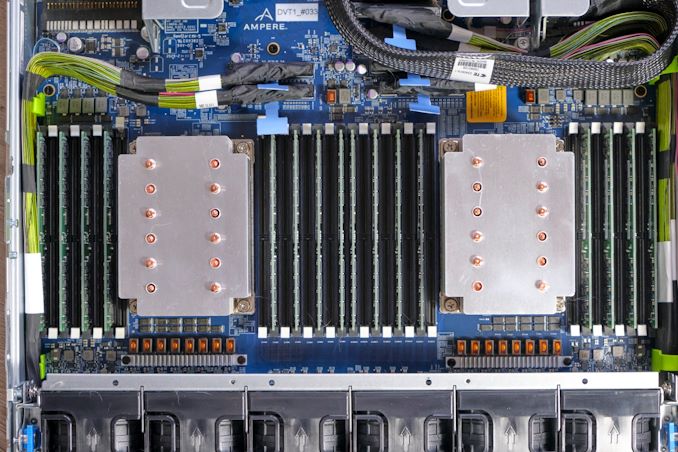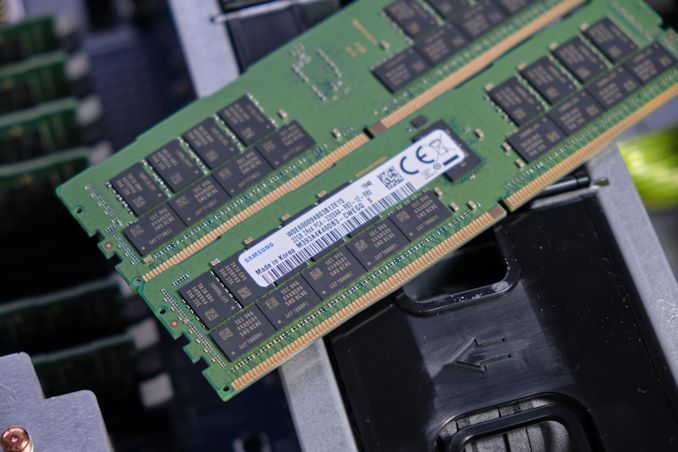The Ampere Altra Review: 2x 80 Cores Arm Server Performance Monster
by Andrei Frumusanu on December 18, 2020 6:00 AM EST- Posted in
- Servers
- Neoverse N1
- Ampere
- Altra
Test Bed and Setup - Compiler Options
For the rest of our performance testing, we’re disclosing the details of the various test setups:
Ampere "Mount Jade" - Dual Altra Q80-33
Obviously, for the Ampere Altra system we’re using the provided Mount Jade server as configured by Ampere.
The system features 2 Altra Q80-33 processors within the Mount Jade DVT motherboard from Ampere.
In terms of memory, we’re using the bundled 16 DIMMs of 32GB of Samsung DDR4-3200 for a total of 512GB, 256GB per socket.
| CPU | 2x Ampere Altra Q80-33 (3.3 GHz, 80c, 32 MB L3, 250W) |
| RAM | 512 GB (16x32 GB) Samsung DDR4-3200 |
| Internal Disks | Samsung MZ-QLB960NE 960GB Samsung MZ-1LB960NE 960GB |
| Motherboard | Mount Jade DVT Reference Motherboard |
| PSU | 2000W (94%) |
The system came preinstalled with CentOS 8 and we continued usage of that OS. It’s to be noted that the server is naturally Arm SBSA compatible and thus you can run any kind of Linux distribution on it.
Ampere makes special note of Oracle’s active support of their variant of Oracle Linux for Altra, which makes sense given that Oracle a few months ago announced adoption of Altra systems for their own cloud-based offerings.
The only other note to make of the system is that the OS is running with 64KB pages rather than the usual 4KB pages – this either can be seen as a testing discrepancy or an advantage on the part of the Arm system given that the next page size step for x86 systems is 2MB – which isn’t feasible for general use-case testing and something deployments would have to decide to explicitly enable.
The system has all relevant security mitigations activated, including SSBS (Speculative Store Bypass Safe) against Spectre variants.
AMD - Dual EPYC 7742
For our AMD system, unfortunately we had hit some issues with our Daytona reference server motherboard, and moved over to a test-bench setup on a SuperMicro H11DSI0.
We’re also equipping the system with 256GB per socket of 8-channel/DIMM DDR4-3200 memory, matching the Altra system.
| CPU | 2x AMD EPYC 7742 (2.25-3.4 GHz, 64c, 256 MB L3, 225W) |
| RAM | 512 GB (16x32 GB) Micron DDR4-3200 |
| Internal Disks | OCZ Vector 512GB |
| Motherboard | SuperMicro H11DSI0 |
| PSU | EVGA 1600 T2 (1600W) |
As an operating system we’re using Ubuntu 20.10 with no further optimisations. In terms of BIOS settings we’re using complete defaults, including retaining the default 225W TDP of the EPYC 7742’s, as well as leaving further CPU configurables to auto, except of NPS settings where it’s we explicitly state the configuration in the results.
The system has all relevant security mitigations activated against speculative store bypass and Spectre variants.
Intel - Dual Xeon Platinum 8280
For the Intel system we’re also using a test-bench setup with the same SSD and OS image actually – we didn’t have enough RAM to run both systems concurrently.
Because the Xeons only have 6-channel memory, their maximum capacity is limited to 384GB of the same Micron memory, running at a default 2933MHz to remain in-spec with the processor’s capabilities.
| CPU | 2x Intel Xeon Platinum 8280 (2.7-4.0 GHz, 28c, 38.5MB L3, 205W) |
| RAM | 384 GB (12x32 GB) Micron DDR4-3200 (Running at 2933MHz) |
| Internal Disks | OCZ Vector 512GB |
| Motherboard | ASRock EP2C621D12 WS |
| PSU | EVGA 1600 T2 (1600W) |
The Xeon system was similarly run on BIOS defaults on an ASRock EP2C621D12 WS with the latest firmware available.
The system has all relevant security mitigations activated against the various vulnerabilities.
Compiler Setup
For compiled tests, we’re using the release version of GCC 10.2. The toolchain was compiled from scratch on both the x86 systems as well as the Altra system. We’re using shared binaries with the system’s libc libraries.












148 Comments
View All Comments
Silver5urfer - Friday, December 18, 2020 - link
25% more cores for Zen2 7742 class. If paired with multi socket and then Milan drop in this is not going to be any major breakthrough."The Arm server dream is no longer a dream, it’s here today, and it’s real." lol so until today all the articles on the ARM are not real I guess.
Anyways I will wait for market penetration of this with server share and then see how great ARM is and how bad x86 is going to be as from AT's narrative recently.
Spunjji - Monday, December 21, 2020 - link
Are you this mopey every time there's a paradigm-shift in the tech industry? Feel free to keep looking for metrics that "prove" you right, but eventually it's going to be a very hard search.eastcoast_pete - Friday, December 18, 2020 - link
Thanks Andrei! Maybe I am barking up the wrong tree here, but I find the "baby" server chip in that lineup particularly interesting. Nowhere near as fast as this, of course, but for $ 800, it might make for a nice CPU for a basic server setup; nothing fancy, but low TdP, and would probably get the job done. The question here is how expensive the MB for those would be.Lastly, if Ampere sends you one of those $ 800 ones, could/would you test it?
Wilco1 - Friday, December 18, 2020 - link
They will likely sell desktops using these just like the previous generation, but they are not cheap as it is high-end server gear using expensive ECC memory (and lots of it since there are 8 channels). If you don't need the fastest then there is eg. NVIDIA Xavier or LX2160A (16x A72) boards for around $500.Spunjji - Monday, December 21, 2020 - link
I think those are probably most useful for workloads that are pathologically memory and/or I/O limited - 4TB per socket, save ~$3000 over the faster CPU, benefit from power savings over the life of the server.twtech - Friday, December 18, 2020 - link
Ironically, AMD's opportunity to win might turn into an ultimate loss - Intel's manufacturing advantage kept x86 relevant, and with access to the x86 instruction set limited by ownership of the IP, AMD lived alongside Intel in that walled garden.With the manufacturing advantage gone however, Apple has left the garden, and maybe other personal computers won't be far behind - software compatibility I think is actually less of an issue in the era of SaaS and continuous updates. Ie. you were going to have to download new versions of the software you use as time went on anyway.
FunBunny2 - Friday, December 18, 2020 - link
"you were going to have to download new versions of the software you use as time went on anyway."Solar Wind? :)
lorribot - Friday, December 18, 2020 - link
This is all great but when all licencing is per core it limits the usage scenarios or benefits of these developments as they can really only be used with open source type licences.For the rest of us on Windows, Oracle, Java, Apple, IBM, etc licencing it doesn't bring anything to the table.
The_Assimilator - Friday, December 18, 2020 - link
Just in time to be obsoleted by Milan.Spunjji - Monday, December 21, 2020 - link
For a given definition of "obsoleted", where it means "still more than competitive in performance per dollar at a lower price of entry".